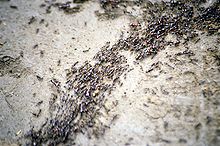
Stigmergy (/ˈstɪɡmərdʒi/ STIG-mər-jee) is a mechanism of indirect coordination, through the environment, between agents or actions.[1] The principle is that the trace left in the environment by an individual action stimulates the performance of a succeeding action by the same or different agent. Agents that respond to traces in the environment receive positive fitness benefits, reinforcing the likelihood of these behaviors becoming fixed within a population over time.[2]
Stigmergy is a form of self-organization. It produces complex, seemingly intelligent structures, without need for any planning, control, or even direct communication between the agents. As such it supports efficient collaboration between extremely simple agents, who may lack memory or individual awareness of each other.[1][3]
- ^ a b Marsh, L.; Onof, C. (2008). "Stigmergic epistemology, stigmergic cognition" (PDF). Cognitive Systems Research. 9 (1–2): 136–149. doi:10.1016/j.cogsys.2007.06.009. S2CID 23140721.
- ^ Lewis, Ted G. (June 12, 2012). "Cognitive stigmergy: A study of emergence in small-group social networks". Cognitive Systems Research. 21: 7–21. doi:10.1016/j.cogsys.2012.06.002. S2CID 40532871.
- ^ Heylighen, Francis (December 1, 2015). "Stigmergy as a universal coordination mechanism I: Definition and components". Cognitive Systems Research. 38: 4–13. doi:10.1016/j.cogsys.2015.12.002. S2CID 16431291.